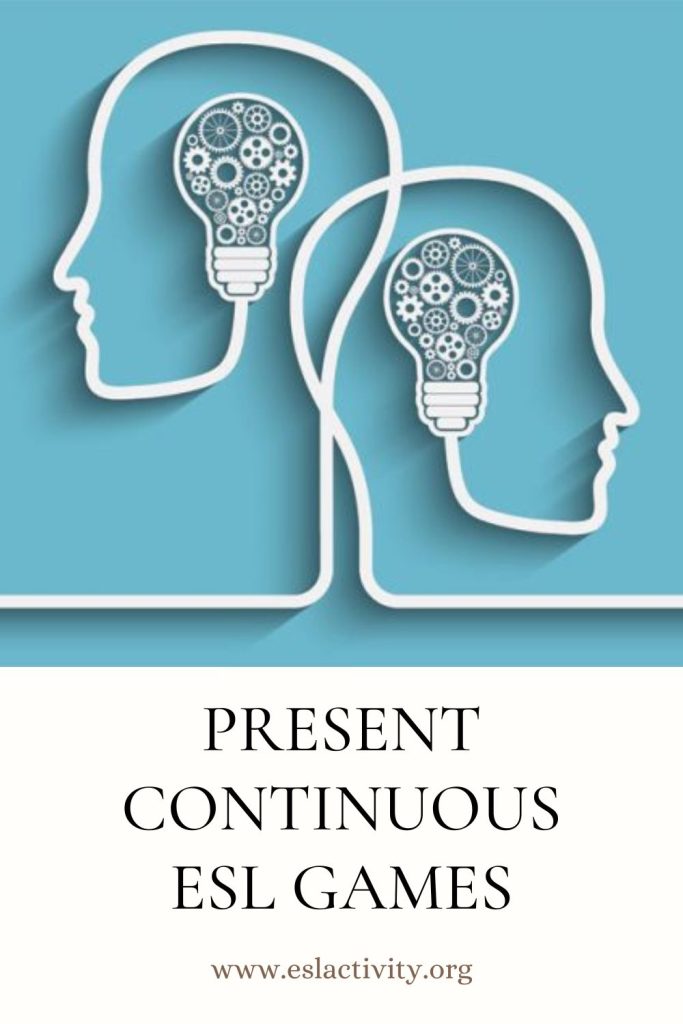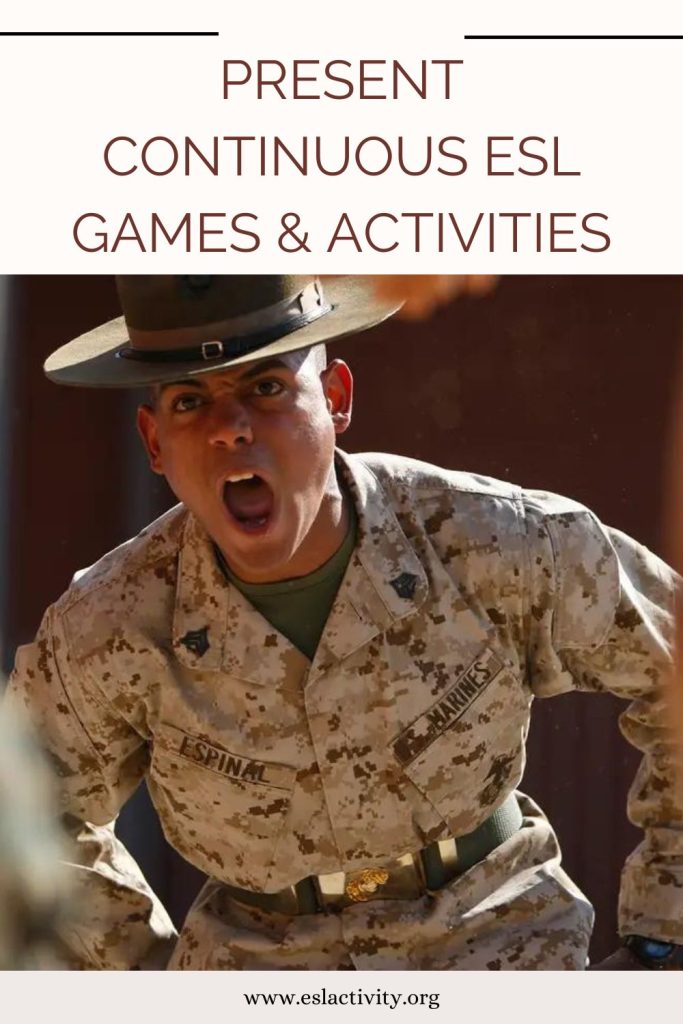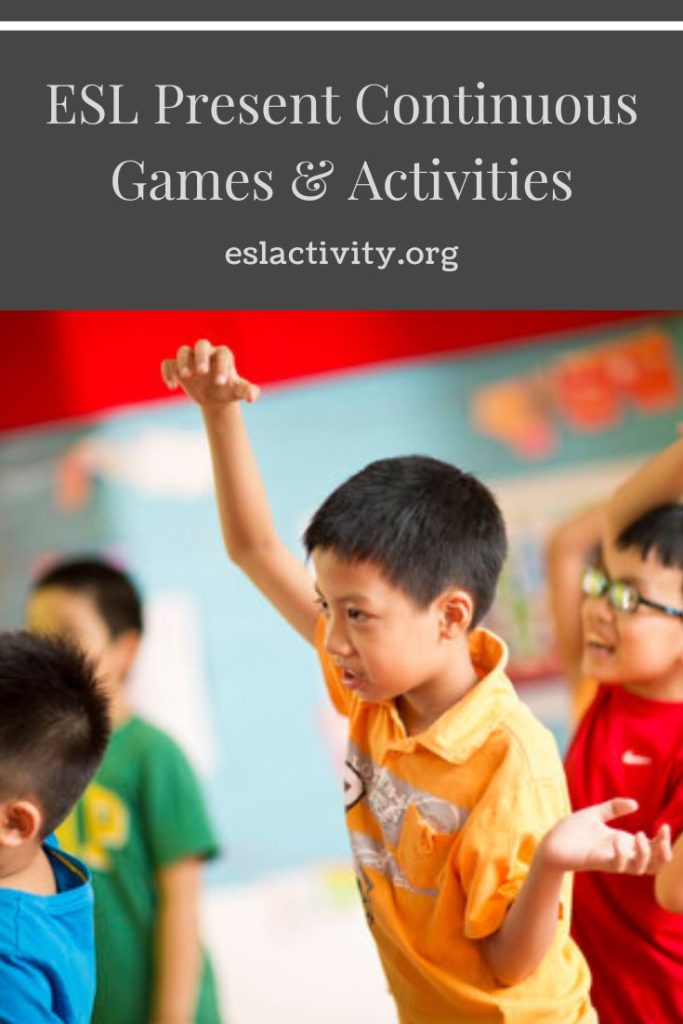
If you’re looking for some of the best present continuous activities, games, lesson plans, and worksheets, then you’re in the right place. Keep on reading for the top recommendations for teaching this important grammar point.

Present continuous games
Let’s get into the best ESL activities for the present continuous.
A nice present continuous game is Pictionary. Students have to draw a person/people doing something. For example, “They are playing soccer.” Their teammates have to make the complete sentence in order to get the point.
This is one of my favourite TEFL games for building sentences. It goes take a bit of preparation but it’s totally worth it! Students love this game. Have a look here for all the details:
Please enable JavaScript
In small groups, students have to brainstorm as many excuses as possible for why someone can’t come to the phone. For example:
A nice TEFL warm-up activity for teaching the present continuous is to show a picture with lots of action in it. Then, elicit some answers from the students. For example,
I love to to use this activity because it takes something old (error correction) and makes it new again by turning it into a game. It’s ideal for grammar concepts that have some nuance to them, like this one. Have a look:
This is such a great ESL activity! It covers all 4 skills, can be used for just about any topic or grammar point, and it also gets the students out of their seats and moving around the classroom. Check it out:
Please enable JavaScript
A nice way for beginners to practice the present continuous is to use some flashcards of people doing some action. Then, students have to make a complete sentence. For example:
Try out this very simple partner or small group activity. The first student has to mime an action (brushing my hair) and the other student can say what he or she is doing. The students can then switch roles.
Try out this challenging listening activity for slightly higher-level students. Find, or write a passage containing numerous instances of the present continuous. Then, students have to listen and try to recreate what they just heard. Find out more about it here:
Have some fun with this one! I ask my students to brainstorm as many things as they can about what can happen in a classroom. For example,
You get the idea! You can also give some different scenarios, like in a coffee shop, or nightclub.

Present continuous ESL activities
One of the games that I like to use for the present continuous is charades. I give students a phrase and they have to act it out. For example:
Put students in groups, depending on the number of magazines that you have. Then, ask students to find someone doing something. For example:
The students have to race to be the first to find that person.
The present continuous can get a little bit tricky because the sentences have helping verbs in them. This is particularly true with the negative and questions forms. Try out this simple activity where students have to put the words in the correct order.
I love to include some videos in my lessons. They are ideal for:
It’s easy to plan your own ESL speaking lesson for just about anything, including this grammar point. Have a look at the simple steps to follow:
Please enable JavaScript
This is a fun activity that works well for smaller classes. Everyone can stand up and do something. The students should pay attention to what everyone else is doing. For example:
Then, the teacher asks one student to close his or her eyes. The teacher asks, “Who is standing on one leg?” The student with her or her eyes closed has to guess who.
It’s easier than you might think to plan your ESL reading lesson for just about any grammar point, including this one. The main advantage to designing your own is that you can target it exactly to the level of students and what you want to teach. Check out this article for the simple steps to follow:
A nice way to review the present continuous is to do some proofreading and editing. Write a passage containing numerous instances of the target grammar. Then, make some mistakes, both in form and meaning. Students have to correct them. This makes a nice exam question or homework assignment as well.
Students have to think of a certain job, and then give 1-2 hints about what that person might be doing right now. For example:
Find a video with a lot of action. Write down some sentences on the board that are the same, or similar to what is happening. For example:
Students have to watch the video and decide which statements are true, and which ones aren’t.

Play present continuous
Create a worksheet with a grid containing different present continuous sentence prompts, such as “Someone who is reading a book” or “Someone who is listening to music.” Students walk around the class asking their peers questions using this verb tense tense to find someone who matches each prompt. They write down the names of the classmates who fit each description.
Students work in pairs or small groups. Each student takes turns interviewing their classmates by asking questions about what they are currently doing using the present continuous tense. For example, “What are you wearing?” or “What are you eating for lunch?” They write down their classmates’ answers and report back to the class.
Divide the class into groups. Each group is assigned a specific daily routine scenario, such as getting ready in the morning or preparing dinner. Within their groups, students create and act out short skits using the present continuous tense to describe the actions they are performing during their assigned routine.
Create a board game where students move their game pieces by forming present continuous sentences. Each space on the board should have a picture or a prompt that requires the student to create a sentence using the target grammar. For example, a picture of someone playing soccer might prompt the sentence “He is playing soccer.” Students take turns rolling the dice, moving their game pieces, and forming sentences.
If you’re a teacher, then you already know how much time it can save to use materials that other teachers have created. That’s where these lesson plans come in. Have a look at some of the top options to teach the present continuous:
If you’re looking for some ideas for the past, have a look here: Past Continuous ESL Games and Activities.
Here are some of the best worksheets for student practice:
If your students want some extra practice opportunities for learning the present continuous tense, here are the sites that I recommend:
The key to better language classes is a variety of interesting, engaging, and interactive games and activities. 101 ESL Activities for Adults will help you get there in style! You’ll find dozens of fun activity options for teenagers and adults.
Pick up a copy of the book today and get ready for better English classes tomorrow.

Here are the answers to some of the most common questions that people have about teaching the present continuous.
To teach the present continuous, first set the context. You could talk about what people are currently doing in the classroom (teaching, listening to the teacher, writing something). Then, introduce the grammar, and have students practice.
To explain the present continuous, explain that it’s used when an action is happening now and that it often continues into the future.
The rule of present continuous is to use the “be” verb in the present tense, plus the participle form of the main verb (ing form). For example, “He is playing soccer.”
Some effective ways to teach the present continuous tense include using visual aids, gestures, and real-life examples. Engage students in role plays, use interactive activities, and provide plenty of practice exercises.
Yes! You can play a “What’s happening?” game. Show students pictures of various activities, and have them describe what is happening in each picture using the present continuous tense. For example, “He is swimming in the pool.”
Some common mistakes include forgetting to use the verb “to be” in the present tense or using the wrong form of the present participle (-ing form) of the main verb.
No, the present continuous tense uses the present participle (-ing form) of the main verb, which is the same for regular and irregular verbs.
Encourage learners to engage in activities where they can use the present continuous tense, such as describing what they are doing at different times during the day or talking about ongoing events in their lives.
Some common adverbs and time expressions used with the present continuous tense include “now,” “at the moment,” “right now,” “currently,” “these days,” and “today.”
Do you have any tips, tricks, games or activities that you use when teaching the present continuous? Leave a comment and let us know. We’d love to hear from you.
Last update on 2022-07-17 / Affiliate links / Images from Amazon Product Advertising API
Jackie Bolen has been teaching English for more than 20 years to students in South Korea and Canada. She's taught all ages, levels and kinds of TEFL classes. She holds an MA degree, along with the Celta and Delta English teaching certifications.
Jackie is the author of more than 100 books for English teachers and English learners, including Business English Vocabulary Builder, 67 ESL Conversation Topics,and 39 No-Prep/Low-Prep ESL Speaking Activities for Teenagers and Adults. She loves to share her ESL games, activities, teaching tips, and more with other teachers throughout the world.